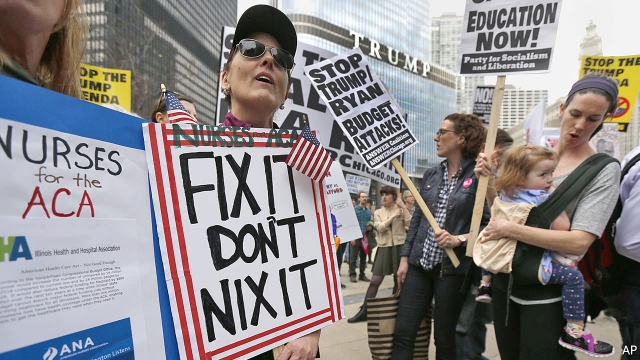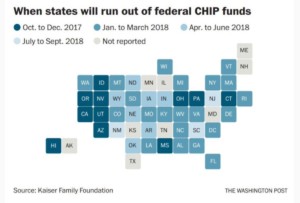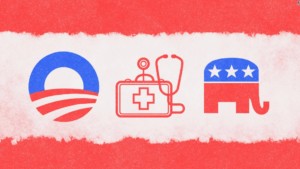The Economist- Aug 31st 2017 | WASHINGTON, DC
Though insurers remain, Obamacare is teetering in places
NOT long ago, America’s health-insurance markets seemed to be drying up. In June 49 counties lacked any willing providers for the “individual market”, which serves 18m Americans who are not covered by an employer or the government. The Affordable Care Act, Barack Obama’s health-care law, seemed to have failed these places. Frantic efforts by state officials have filled the gaps: Nevada’s governor claims to have interrupted a hiking trip with his daughter to broker a deal covering most of his state. The last empty market, in Ohio, gained an insurer on August 24th. But failure has not yet been averted. With health reform stalled in Congress, several states are rushing to patch things up themselves before insurance for 2018 goes on sale in November.
Obamacare’s markets were always likely to limp on rather than collapse utterly, because they have a blank cheque from the federal government. The law caps premiums for buyers who earn less than four times the poverty line (this year the cut-off is $48,240 for an individual). No matter how high premiums rise and how many healthy people leave the market, some subsidised enrollees, who have already reached their premium caps, will keep buying. The only surprise is that it has taken so much cajoling to get insurers to run monopolies in markets buttressed by such generous government support.
Yet rising premiums are a big problem for many of the 9m Americans who buy insurance for themselves without any government help. In Iowa about 28,000 people are on the hook, according to Doug Ommen, the state’s insurance commissioner. As things stand, only one firm, Medica, will sell policies there next year. Already-high premiums will rise by 44%—more, if President Donald Trump cuts off some subsidies for insurers, as he has threatened to do. A hypothetical couple of 55-year-olds together earning just under $67,000 would face an annual bill of nearly $33,000 for coverage. Faced with such prices, Mr Ommen reckons that between 18,000 and 22,000 Iowans will drop their coverage in 2018. So on August 22nd Iowa formally asked the Trump administration for permission to overhaul Obamacare at a local level.
It is not alone. Minnesota and Oklahoma have also submitted reform proposals, and others may follow. Each state wants to provide “reinsurance”—jargon for assuming some of insurers’ risks themselves. For instance, Minnesota proposes to foot the bill for 80% of enrollees’ medical costs between $50,000 and $250,000. The model is tried and tested: the federal government provided reinsurance for the first three years of Obamacare. This year Alaskan taxpayers began footing the bill for people suffering from 33 costly medical conditions, including HIV. This kept premium rises down to 7%—low by national standards—and in 2018 they are set to fall by over a fifth.
Reinsurance is bad for taxpayers. But it is fairer than the current set-up. As it stands, Obamacare guarantees coverage for the ill and funds their care through inflated premiums only in the individual market. The 155m Americans who get coverage from their employers escape the costs. Spreading the bill across all taxpayers makes more sense. The thinking is similar to that behind “high-risk pools”, an idea small-government conservatives like.
Yet the states have differing ideas about precisely which taxpayers should pay. All want the federal government to hand over the cash it will save on subsidies for the poor when premiums fall. (Alaska, which fully funded its programme this year, has had a similar request approved.) Minnesota and Oklahoma would make up the remainder themselves. But Iowa does not want to stump up any cash. Instead, Mr Ommen proposes to repurpose some of the federal money for poorer buyers. Fixed dollar subsidies would replace premium caps. Those who currently get help with their out-of-pocket costs would instead face a $7,350 deductible.
The plan risks running foul of the law, which forbids states from experimenting in ways that make coverage less affordable. But the Trump administration has some leeway to interpret the rules so that Iowa’s plan becomes permissible, says Jennifer Tolbert of the Kaiser Family Foundation, a think-tank. The state says it consulted the administration while writing its proposal.
If, as seems likely, the plan is approved, other states may put forward still more radical ideas. Oklahoma is contemplating asking permission to rewrite the rules governing what insurers must cover, an idea popular with Republicans. Elsewhere, Democrats seek to make government-provided insurance—a “public option”—available to all. (In June, Nevada’s governor vetoed such a proposal.) For now, simply averting disaster should be the goal. The individual health-insurance market is vital for states’ economies; without it, entrepreneurs would have to risk their health as well as their capital. Self-employed business owners may flee states where premiums are exorbitant.
There is still time for Congress to pass a bipartisan fix. On August 28th Governors John Kasich of Ohio and John Hickenlooper of Colorado said they were on the brink of releasing such a plan. It might include federal reinsurance. But if lawmakers in Washington cannot agree, states will have to fill the void.
Questions about ACA, private Medical Insurance and health insurance reimbursement? Physician Credentialing and Revalidation ? or other changes in Medicare, Commercial Insurance, and Medicaid billing, credentialing and payments? Call the Firm Services at 512-243-6844




